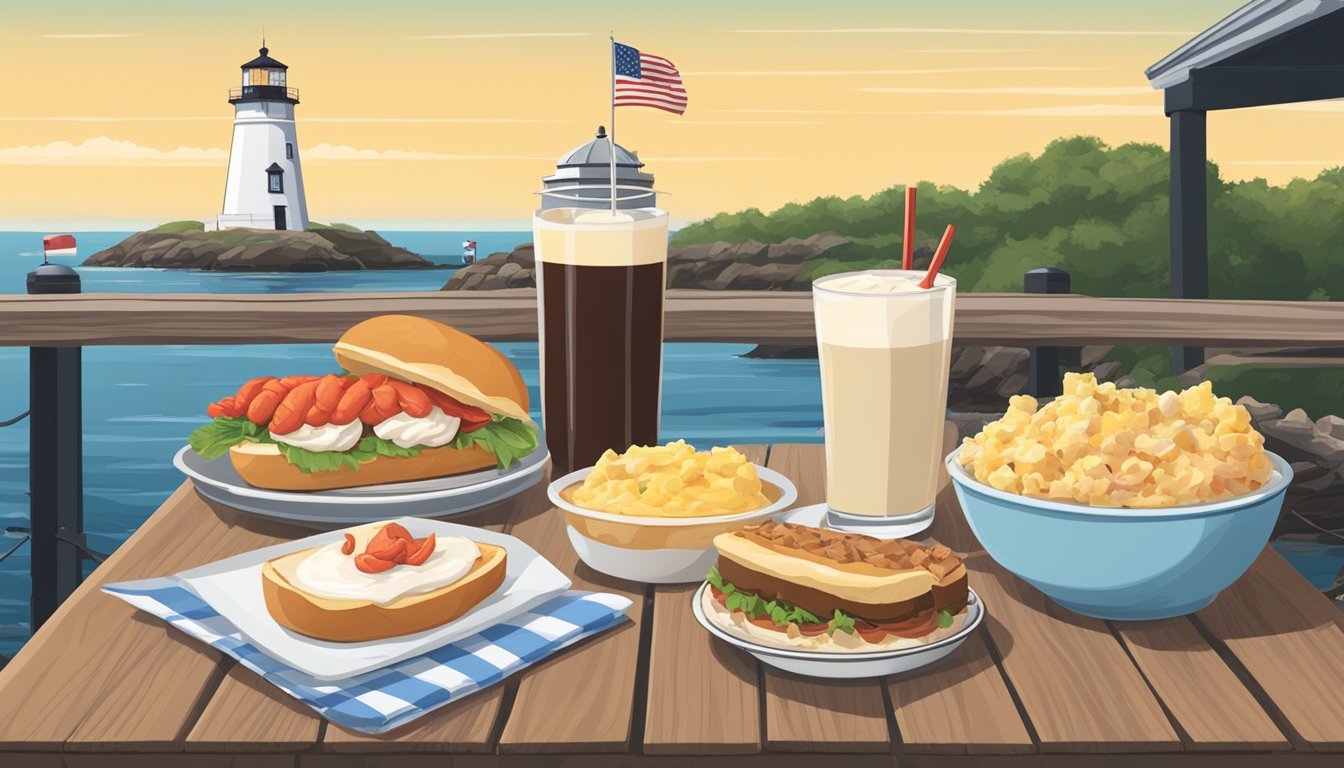What Food is Massachusetts Known for?
Unveiling New England's Culinary Delights
Massachusetts, steeped in history and tradition, is not just famous for its pivotal role in American history but also for its distinctive food scene that embodies the essence of New England cuisine. The state's culinary offerings are a reflection of its historical seafood (What wine goes well with seafood?) industry, with the coastal waters providing a bounty that has shaped the local diet. Lobsters (What wine goes well with lobster?), clams (What wine goes well with clams?), and oysters are hallmarks of the region, frequently served in clam shacks along the coastline or featured as prized components in festive clambakes, a New England tradition that brings communities together over a feast of seafood, corn, and potatoes, usually cooked in a pit on the beach.
Beyond the seafood, the state has given rise to unique and traditional dishes that are cherished by locals and sought after by visitors. One such invention is the fluffernutter, a sandwich made with peanut butter (how long does peanut butter last?) and marshmallow fluff – a creamy confection that originated in Massachusetts. Baked goods also claim their spot in Massachusetts' famed food lineup, with offerings like the chocolate chip cookie born here, and regional specialties such as the grilled blueberry muffin and apple cider doughnuts signaling the state's love for comforting sweets.
Massachusetts' foods tell a story of cultural fusion and local pride. Portuguese pastries reflect the influence of immigrant communities, while iconic dishes like Boston baked beans (how long di baked beans last?) and Boston cream pie embody the state's culinary heritage. With each bite, whether from a trendy Boston eatery or a roadside stand in the rural Berkshires, Massachusetts presents a palate that's as rich in flavor as it is in history.
Historical Roots of Massachusetts Cuisine
Massachusetts's cuisine presents a rich tapestry woven from its colonial past and Native American heritage, with iconic dishes that have gained national fame. This section explores the development of Massachusetts's culinary identity through historical influences and cultural significance.
Colonial Influence and Native Ingredients
Massachusetts's early food culture was heavily influenced by both the English colonists and the region's indigenous tribes. Native ingredients like corn, beans, and squash, crucial to the local Algonquian diets, were adopted by the settlers and remain staples in New England fare. The ready availability of seafood, including cod and clams along the Atlantic coast, also shaped the culinary landscape.
Development of Iconic Dishes
Iconic Massachusetts dishes have origins deeply rooted in the state's history. Boston baked beans, a quintessential dish, is a direct legacy of the colonial era, utilizing native ingredients like navy beans and molasses (how long does molasses last?), with the addition of salt pork. Similarly, the Boston cream pie, created at the Parker House Hotel (now the Omni Parker House Hotel), became the state dessert of Massachusetts, demonstrating the historical significance of the state’s culinary contributions.
Culinary Innovations and Claims to Fame
Massachusetts can lay claim to several culinary firsts and innovations. Parker’s Restaurant within the Omni Parker House Hotel famously introduced the Boston cream pie. Moreover, the chocolate chip cookie was born at the Toll House Inn, and the Fluffernutter—a peanut butter and marshmallow fluff sandwich—owes its existence to Massachusetts inventors. Fenway Park, the iconic baseball stadium, popularized Fenway Franks, their own take on the hot dog.
Cultural and Community Impact on Cuisine
Cuisine in Massachusetts has been shaped significantly by the community and cultural context. The state’s signature offerings, such as baked beans and seafood chowders, reflect the blending of Native American culinary techniques with European settlers’ tastes, creating a unique New England culinary identity. Festivals, community gatherings, and family traditions continue to celebrate and preserve these historic flavors, ensuring that Massachusetts cuisine remains an integral part of both community and cultural identity.
Massachusetts Seafood Specialties
Massachusetts is renowned for its rich seafood traditions, offering some of the freshest and most iconic dishes along the East Coast. The Bay State's close community ties to the sea provide an abundant array of seafood delicacies that are a must-try for anyone visiting the region.
Lobster and the Famous Lobster Roll
The lobster roll stands as a culinary icon in Massachusetts, particularly on Cape Cod and the North Shore. This beloved sandwich cradles succulent lobster meat, lightly dressed with mayonnaise or butter, within a toasted split-top bun. Neptune Oyster in Boston is famed for its take on the lobster roll, offering both a cold version with mayonnaise and celery and a hot variant with butter.
Clam Chowder: A New England Staple
Arguably one of the most defining dishes of New England fare, the New England clam chowder is a creamy concoction cherished in Massachusetts. Characterized by tender clams, diced potatoes, onions, and enriched with milk or cream, it exemplifies comfort food. Establishments across Massachusetts, from the city to ACK (Nantucket), take pride in their chowder, often accompanied by a side of savory, buttery cornbread.
Oysters, Scallops, and Beyond
Massachusetts waters are brimming with a variety of bivalves such as oysters and scallops (What wine goes well with scallops?), integral to the state's seafood offerings. Restaurants like Neptune Oyster are acclaimed for their raw bars presenting freshly shucked oysters with a crisp, clean taste reflective of the Atlantic. Furthermore, seafood platters often feature fried clams and broiled or fried scallops, available throughout seaside communities and synonymous with the indulgence of Massachusetts seafood.
Baked Delights and Desserts
Massachusetts takes pride in its rich assortment of baked goods and desserts, offering a delightful experience for those with a sweet tooth. From the official state dessert to Italian-inspired pastries, the state’s offerings are deeply rooted in its history and communities.
Boston Cream Pie and More
The Omni Parker House Hotel is the birthplace of the Boston Cream Pie, Massachusetts' celebrated state dessert. Contrary to its name, this treat is not a pie but a cake, consisting of layers of moist sponge cake filled with rich pastry cream and topped with a smooth chocolate glaze. Its fame has placed it at the heart of Massachusetts' culinary identity, serving as a staple in bakeries throughout the state.
Signature Dessert: Boston Cream Pie
Consists of: Sponge cake, pastry cream, and chocolate glaze
Place of Origin: Omni Parker House Hotel, Boston
The Legendary Cannoli of North End
Boston's North End neighborhood, often referred to as "Little Italy," is renowned for its cannoli—a crispy pastry shell filled with sweetened ricotta cheese and often garnished with pistachios, chocolate chips (how long do chocolate chips last?), or candied fruit. (how long does candied fruit last?) A visit to Mike’s Pastry or other local bakeries is considered essential for those seeking the authentic taste of this Italian dessert that has been perfected over generations.
Main Components: Ricotta-filled pastry shell, various garnishes
Key Location: North End, Boston
Famous Spot: Mike’s Pastry
Apple Cider Donuts and Regional Sweets
In the fall, apple cider donuts (how long do donuts last?) become a cherished treat in Massachusetts, especially in places like Concord and Brookline. These donuts, made with local apple cider and often coated with cinnamon sugar or maple syrup (how long does maple syrup last?), embody the flavors of New England. They symbolize the state's appreciation for seasonal produce and traditional recipes passed down through the years.
Seasonal Favorite: Apple Cider Donuts
Ingredients: Local apple cider, often with cinnamon sugar or maple glaze
Notable Areas: Concord, Brookline
Casual Eats and Street Food
Massachusetts's casual dining landscape offers a rich tapestry of flavors, with street foods that are deeply ingrained in the local culture. From iconic hot dogs at Fenway Park to unique peanut butter and marshmallow sandwiches, these eats are not just food, but a part of the community's identity.
The Quintessential Fenway Frank
Fenway Park is not just a baseball mecca; it's also the home of the Fenway Frank, Massachusetts's take on the classic American hot dog. Beloved by generations of sports fans, these franks are often boiled and grilled, creating the perfect blend of snappy casing and smokey flavor.
Ingredients: Prime beef, ballpark bun, traditional condiments
Location: Fenway Park and local vendors
Fluffernutter: A Unique Massachusetts Creation
The Fluffernutter sandwich is a beloved concoction originating from Massachusetts, combining creamy peanut butter with sweet marshmallow fluff. The latter, known simply as "Fluff", is a proud invention of the state and is a staple in many childhood memories.
Components: Peanut butter, marshmallow fluff, white bread
Cultural Significance: Represents a piece of Massachusetts's culinary history
Sweet and Salty Staples
Massachusetts's street food scene also features sweet treats and salty delights that showcase the state's culinary diversity. While Boston Baked Beans—made with a melody of navy beans (how long do navy beans last?), molasses, salt pork or bacon, and a hint of mustard—are a savory classic, other items like apple cider donuts satisfy the sweet tooth of locals and visitors alike.
Signature Ingredients: Salt pork, bacon, molasses, navy beans
Pairings: Often enjoyed with a side of brown bread or at traditional New England gatherings
Distinctive Food Experiences in Massachusetts
In Massachusetts, visitors and locals alike have the opportunity to engage with the state's rich culinary heritage through historic dining locations, guided food tours, and vibrant markets offering local produce.
Historic Restaurants and Dining Establishments
Massachusetts is home to some of the oldest and most storied dining establishments in the United States. The Union Oyster House, located in Boston, holds the distinction of being America's oldest restaurant, having opened its doors in 1826. Additionally, the Omni Parker House Hotel is credited with the creation of the Boston Cream Pie and Parker House Rolls, making it a must-visit for those in search of authentic New England fare. In Cambridge, Oleana offers a contemporary twist on regional ingredients, showcasing the diversity of Massachusetts' culinary offerings.
Food Tours and Culinary Walks
To truly understand Massachusetts food, one might consider joining a food tour in areas like the historic North End of Boston, where the community's Italian cuisine can be savored through a series of tastings. These culinary walks provide an immersive experience, allowing food lovers to explore everything from freshly shucked oysters at Neptune Oyster to iconic American dishes at Beantown Pub.
Farm-Fresh and Local Produce Markets
The focus on farm-to-table dining in Massachusetts encourages a visit to local produce markets where the community gathers to sell and buy the freshest seasonal offerings. Visitors can find a variety of local products, including renowned New England apples, at these community hubs. These markets not only reflect Massachusetts' commitment to fresh and sustainable food but also allow one to sample some of the best foods in Massachusetts, directly from the source.





